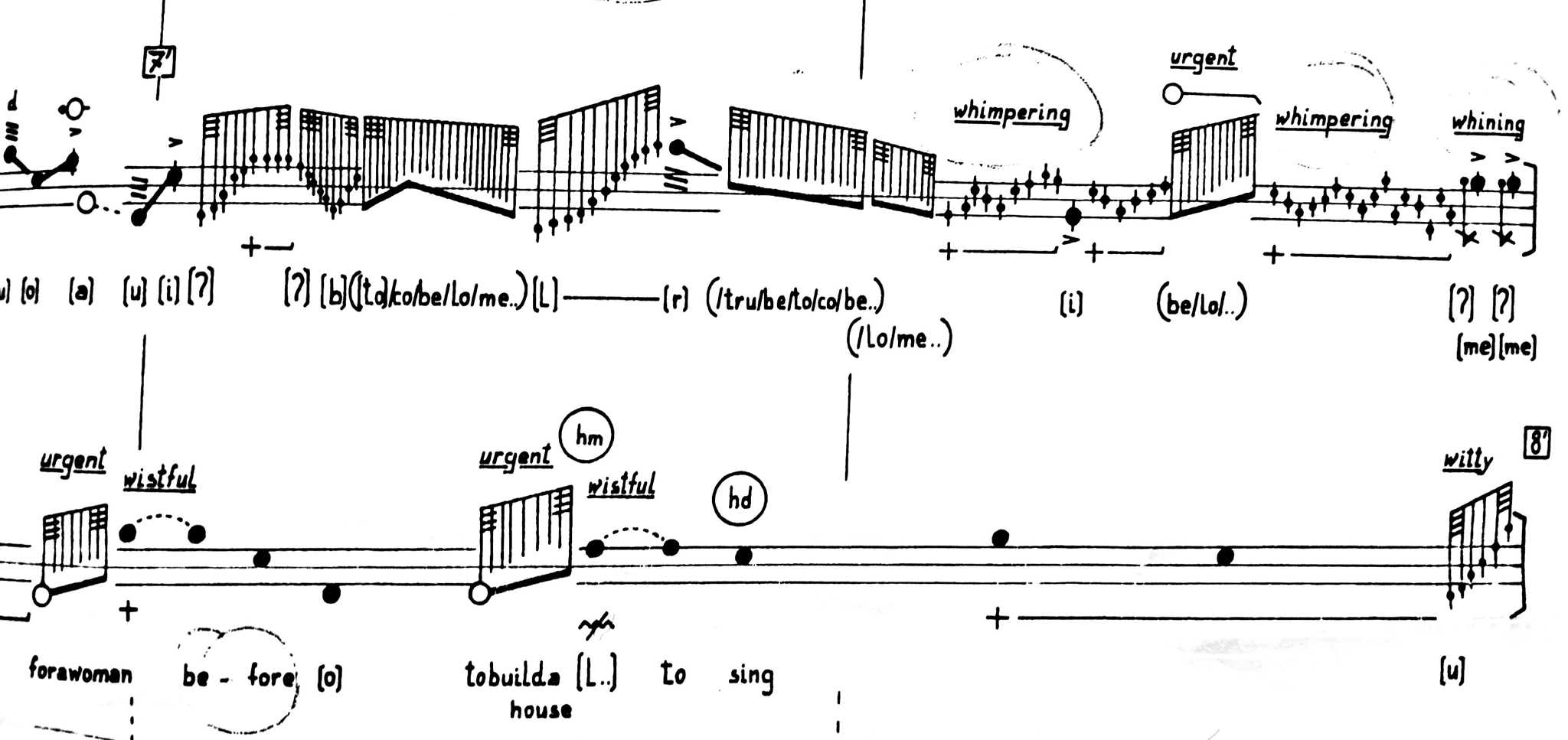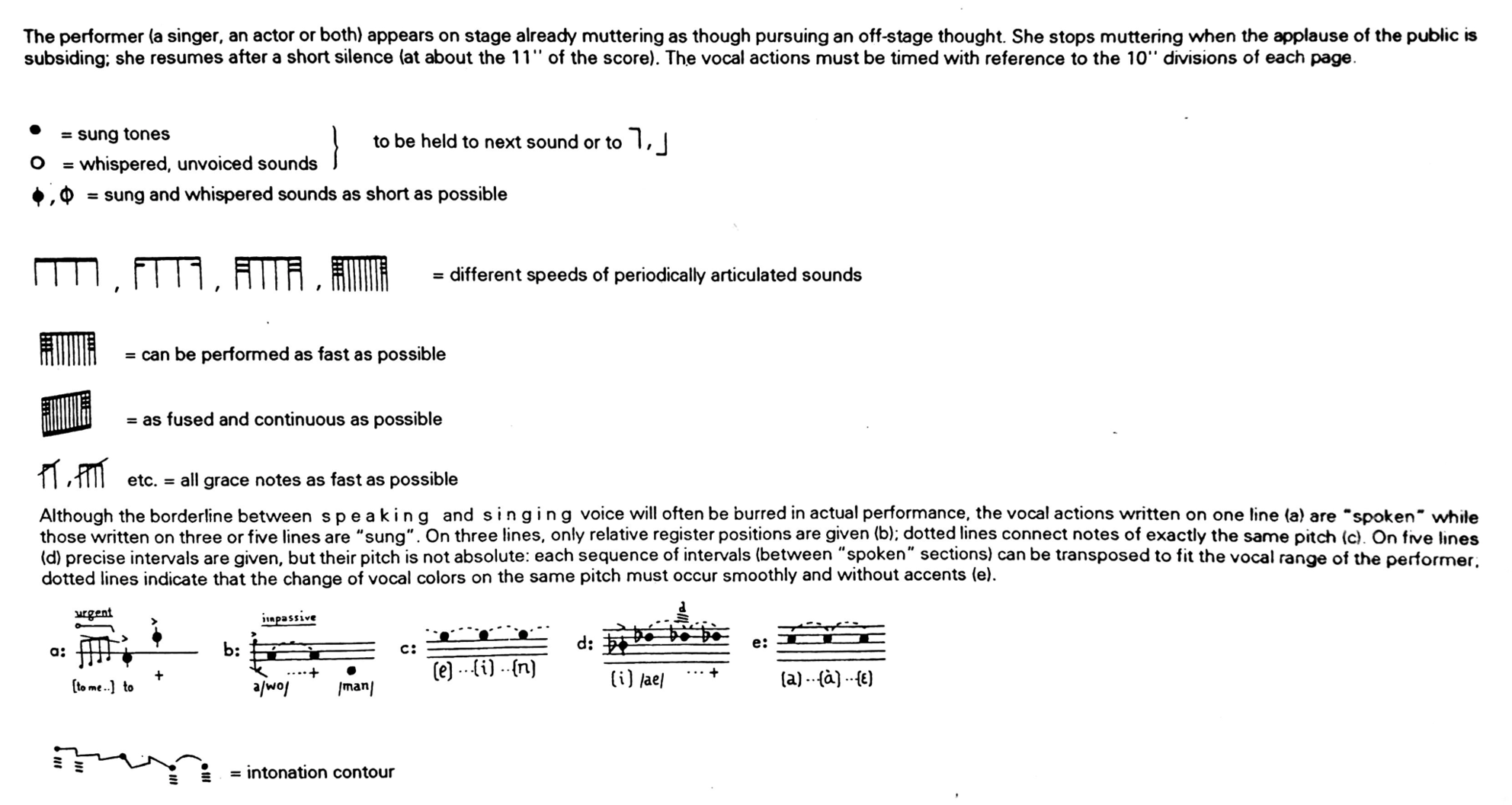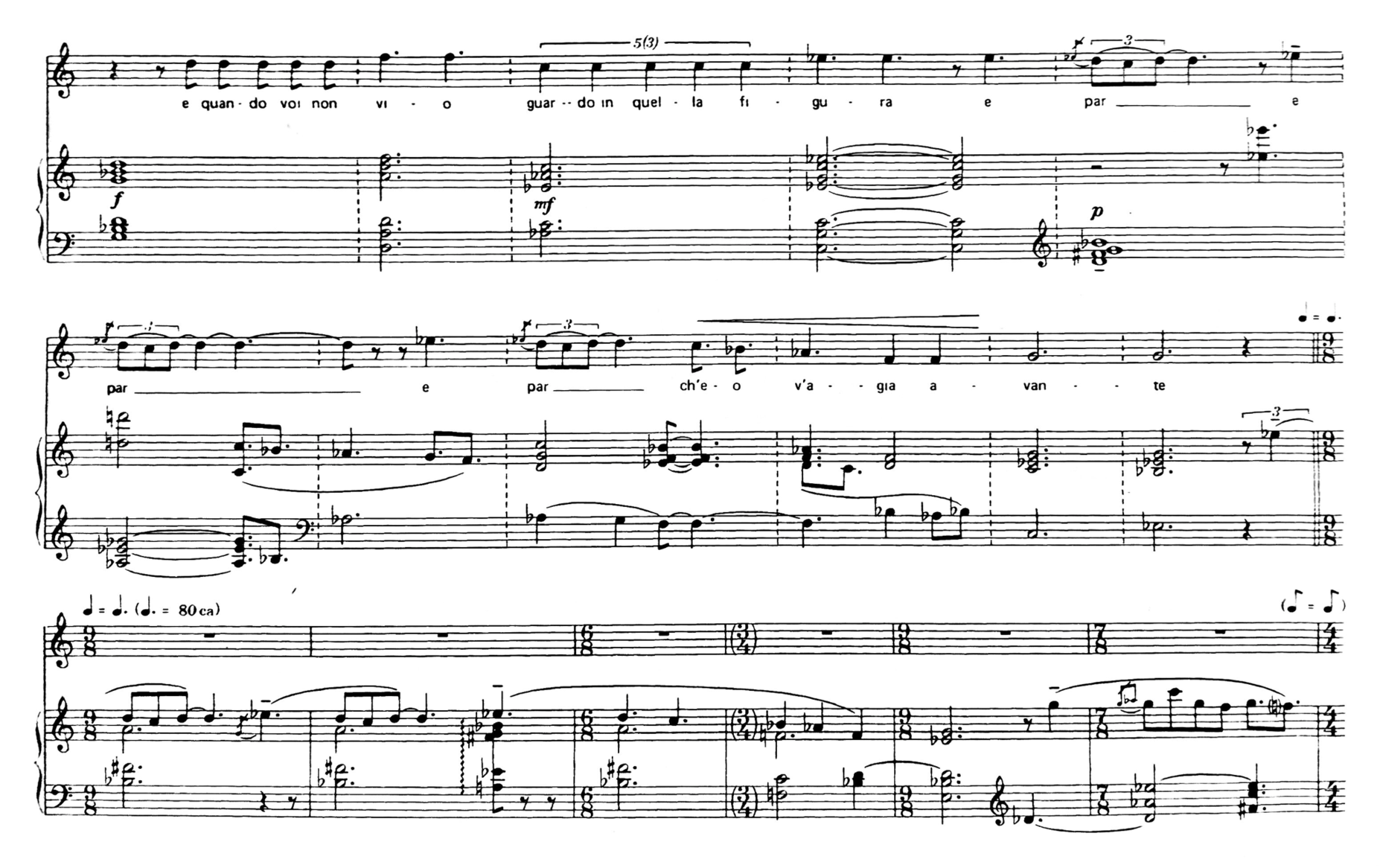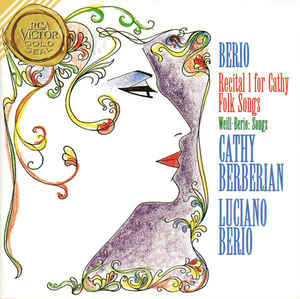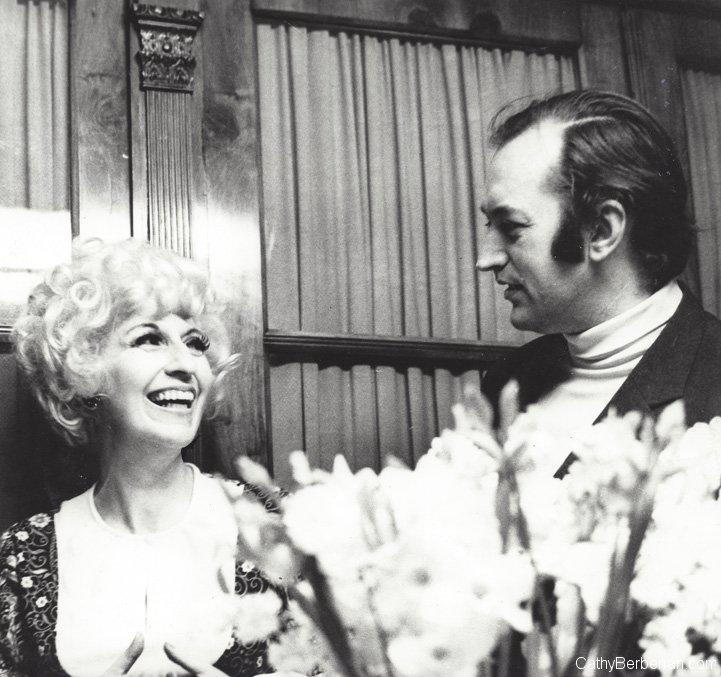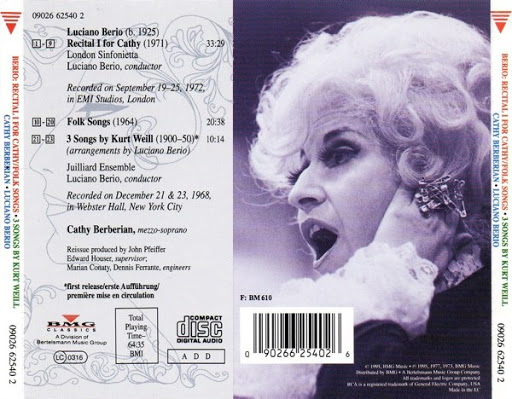The combination of sound fragments and words gives life to a theater for the ears, which allows the listener to perceive as polyphonic what is monodic by nature (the voice). This perception has to be found in the six classes of interaction described by Berio, that are here resumed as follows:
1. Conventional use of the voice that follows the articulation of the words;
2. Modifications of the sounds of the previous class (vocalizing, muttering, whispering,...);
3. Sounds created without the voice intervention (clapping hands, snapping fingers,...);
4. «Vocal gestures» (laughing, panting, coughing, imitating a bird or a saxophone, imitating a jazz style....);
5. Body movements that simulate the sound (ex closing the mouth with on hand);
6. Body movements that do not simulate or producing any sound (as counting the tempo with on hand).1
These six classes are, in their turn, associated to psychological states as «impassive», «wistful», «joyful», «desperate», «whimpering», «urgent», «witty», «distant and dreamy», «ecstatic», etc, suggesting emotional states. Other times the main vocal gesture has to take in consideration additional indications, such as «tense laughter», «open laughter», and so on.
3.2 Luciano Berio and Claudio Monteverdi
Berio says about Monteverdi: «The musical vision of Monteverdi reveals accents and affections in the voice that have never been heard before. Everything is naked, lapidary and noble. This had been the landmark for many representative styles after him, and it is still today a model for many of us...». (C'è musica e musica, RAI, 1972).
In 1945 Berio entered the Conservatory Giuseppe Verdi of Milan, which became the birthplace of his musical vocation. Here, thanks to Giorgio Federico Ghedini - his teacher of composition and prominent figure of the 20th-century Italian musical panorama -he could study Monteverdi and his music which according to him “set the voice free, making the different vocal techniques look all together as a meditation over the multiplicity of the vocal expression”.2
The interest in Monteverdi's music developed in Berio's arrangements of Combattimento di Tancredi e Clorinda (1966), the project of transcription of Orfeo (those were the years when Berio was heading the direction of the LVII Maggio Musicale Fiorentino, and Recital I for Cathy (1971) within which there are two arrangements La lettera amorosa and Il lamento della ninfa.
The admiration for Monteverdi's work is evident both in his arrangements in which the vocal line retains her purity and power, and in the style of composition of pieces like Avendo gran disio (from Quattro canzoni popolari, 1947, also included in Recital I for Cathy together with the arrangement of Monteverdi's music). The style of composition respects the text-music relationship which seems to pay homage to Monteverdi's seconda prattica. Even if harmonies have a sonority far from Monteverdi, they don't overshadow the text, in fact, they contribute to strengthening the meaning.
Avendo grand disio, dedicated to Cathy Berberian is an example of how the rhythmical values of the vocal line are often dictated by the natural accentuation of the words in the parlato. The instrument is always in an open dialogue with the voice, sometimes in a back-and-forth other times commenting and expanding a fragment that has just been sung. Talking about the harmony, the internal voices often interact with the voice, sometimes moving per moto contrario or anticipating a melodic fragment which will be sung in the following bar. The use of the dissonance remains as an expressive element that wants to enforce moment of tension or doubt, or by contrast, of ecstasy or love excitement.
The text is a estract from the poem Meravigliosamente by Jacopo da Lentini (12th/ 13th-century)
In this fragment, it is possible to notice how the small melody that accompanies the words “e par” (which is repeated three times) it is re-elaborated and commented by the piano immediately after.
The three repetitions («e quando voi non vio guardo in quella figura e par, e par, e par ch'eo v'aggia avante») are always alternating pauses which seem to express uncertainty of the character that is trying to find around him the “beautiful face” which is described earlier. One can find this same language in Monteverdi's Arianna, whereas it has been analyzed that these pauses offer to the performer the time to react to the subtext.
Although the text is permeated by the theme of love and it describes the contemplation of the beloved one, the music never gives up to moments of lyrical expansion: singing is always aimed forward and are the musical gestures, which are faithful to the text meaning, to describe feelings without ever being ostentatious.
Talking about gestures, different is the approach to the text of Berio in Sequenza III.
Sequenza III is a composition for only voice (1965-1966) which is part of a cycle of 14 sequences, each one dedicated to a different instrument. In this case, differently from the previous piece, the vocal expressivity is disconnected by the text that is just composition material that will go through a “deconstruction” process.
The text by Markus Kutter presents seven short sentences, open to a certain number of possible combinations:
3. Luciano Berio and the vocal gesture
3.1 The poetics
Fascinated by the vocality of Cathy Berberian and by Luciano Berio's vocal writing, I wrote a thesis in 2016 entitled Luciano Berio and the vocal gesture with the intent to explore his music starting from the understanding of his poetic, what he calls the poetics of gesture. I discovered that his poetics was the result of a fusion of different musical languages and influences that can be summarized as follows: the theatre of Bertolt Brecht and the look at his dramaturgic parameters; the music of Claudio Monteverdi (1567-1643) which have been introduced to Berio by the composer Giorgio Federico Ghedini, his teacher at the Conservatory of Milan; Schönberg and his music, in particular, the studies about Pierrot lunaire; the interest for world folk music that he deepened thanks to the meeting with the ethnomusicologist Roberto Leydi; and the collaboration with Cathy Berberian with whom he went through a fascinating path in the world of the voice.
For Berio, singing is a theater of actions that he calls “vocal gestures”, which are directly connected to human emotions. More specifically a gesture is naturally expressive because it refers to a collective sense of social conventions (for instance, we all agree that coughing to clear the voice indicates a wish to draw the attention, or that producing an inhaled sound indicates a reaction to a shock/surprise). When this gesture is “stolen” from his normal context (in this case everyday life scene between people) and is transferred in music, it's already theater, because it becomes a new expression. Berio talks about “short-circuit” between old and new life of the gesture: thanks to this metamorphosis, the listener finds himself involved in a surprising new expressive language of which he can recognize the material.
Examples:
Sequenza III https://www.youtube.com/watch?v=DGovCafPQAE
Stripsody (Cathy Berberian) https://www.youtube.com/watch?v=0dNLAhL46xM
3.2 Cathy Berberian and the voice as a laboratory of sounds
The meeting with this artist featuring a musical intelligence and a vocal diversity that were allowing her to easily sing early and modern music has been for Berio a very important stimulus to his creativity.
BALLO (Berio)
https://open.spotify.com/track/2WmN4wKomcS5uD1zkaelfn?si=wNZsLSKhQxS7FIdcQn5veQ
LOOSIN YELAV (Berio)
https://open.spotify.com/track/6UR8iwofsEgIlzIsYXhCsH?si=OD_fknB-TI-7QQxmluDY-w
AZERBAIJAN LOVE SONG (Berio)
https://open.spotify.com/track/1E9F4lgt4Xb1nJYxU1jrcZ?si=619bO0MiQXaOEHjLhWYnng
LETTERA AMOROSA (Monteverdi)
https://open.spotify.com/track/7D6sbkKHd9TrxGsg5MXD8Q?si=Cn7Q0fKHSHCTrbIR7sZaLA
SURABAYA JOHNNY (Kurt Weill/Berio)
https://open.spotify.com/track/5IpmvADEp3M57I7awAZ6tm?si=PM8mRztIRfOQi42mYknEIA
Her open mind and her extreme vocal versatility ( her concert entitled “From Monteverdi to the Beatles” was memorable) in addition to her music culture, permitted her to sing everything. To remember her interpretation of Monteverdi with Harnoncourt: the role of Ottavia in Incoronazione di Poppea (1642), La lettera amorosa and the lamento della ninfa.
Voice is an instrument with endless possibilities in expression, and for this reason, it cannot be limited just to one way of singing. This attention and care that the singer dedicates to the vocality that she will choose approaching different repertoires, stimulated the work of Berio in his research of new timbres and colors (in the Folksongs the instruments and the voice play to imitate each others) and his theatrical research, in which the voice is treated as the main actress and the score becomes the stage space where she moves. In Sequenza III the score gives to the singer the opportunity to show her technical abilities and at the same time the opportunity to experiment always new sounds compared to the given indications in terms of dynamics and expressions.
Avendo Gran Disio is the third of the Quattro canzoni popolari for voice and piano, composed in 1947 and is dedicated to Cathy Berberian. With this musical piece, Luciano Berio wanted to honor the vocal virtuosity of his wife, bringing into music all those elements -such as the vocal range- that could have enhanced her talents. I believe that the fact that this piece has been conceived as a gift to vocality, makes the connection between music and text even deeper and stronger, and for this reason, it should maybe be sung not only with a voice that performs but with a voice that composes and creates new meanings.
The quantity and complexity of these six classes which are all related to each others, can easily give an idea of the number of possible combinations that the performer plays with.
I read in Scritti sulla musica in the part dedicated to Sequenza III, that when Berio was about 11, he saw performing his neigbor, the clown Grock, and he didn't know if he was supposed to cry or laugh, but he felt the desire of doing both things at the same time.
I believe that the performer of Sequenza III should “deliver” the emotions as a clown would do: in an expressive way but disconcerting, alienating but strongly descriptive. As Berio said in one of the episodes of C'è musica e musica, it's inevitable to stop thinking about “in how many ways things can be told, in how many ways things can be sung, and in how many ways things can be told in singing”. Talking about Cathy Berberian, Berio says:
« Cathy used her voice as a laboratory of sounds. […] She was always starting from a new love for the vocality, from faith in the possibilities of the human voice. […] She has been a voice that never performed but always composed.[…]».3
Studying the Sequenza III taught the difference between feeling an emotion (personal level), performing an emotion (character level) and describing an emotion (narrator level). I read in the six classes a similarity with the emotional states of the teoria degli affetti (pain, anger, joy...). Even if the intent is probably different, I applied this knowledge to the performance of the Lamento d'Arianna and I have been able to do a step back from the feelings of the character and find myself less involved, but on the other side, I could see more clearly the whole picture and understand better those feelings. Therefore my singing became more stable and more effective at the same time, beacause I was not too emotionally involved anymore and I understood how to transform Arianna's emotions into vocal intentions, basically as Berio calls them, vocal gestures.
III. Avendo gran disìo
dipinsi una pintura,
bella, voi somigliante,
e quando voi non vio,
guardo in quella figura,
e par ch’eo v’aggia avante.
Filled with great love-longing
I painted a picture
resembling you, my fair one,
and when I do not see you
I look upon that image
and think you are before me.4
